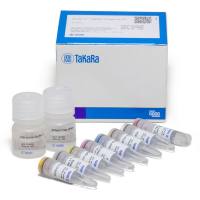High‐Throughput Screening for Protein‐Protein Interactions Using Yeast Two‐Hybrid Arrays
互联网
- Abstract
- Table of Contents
- Materials
- Figures
- Literature Cited
Abstract
Arrays are used for parallel assays of large numbers of proteins in a single experiment. They provide an alternative to libraries for protein screening purposes. This unit describes a protein array composed of living yeast (Saccharomyces cerevisiae ) cells that can be used in a functional screen for protein interactions, the two?hybrid assay. The protocols described here use the yeast proteome as an example, but they can be applied to any other genome or subset thereof.
Table of Contents
- Basic Protocol 1: Construction of a Proteome‐Scale Protein Array for Yeast
- Basic Protocol 2: Manual Screening for Protein Interactions Using a Yeast Protein Array
- Alternate Protocol 1: Robotic Screening for Protein Interactions Using a Yeast Protein Array
- Reagents and Solutions
- Commentary
- Figures
Materials
Basic Protocol 1: Construction of a Proteome‐Scale Protein Array for Yeast
Materials
Basic Protocol 2: Manual Screening for Protein Interactions Using a Yeast Protein Array
Materials
|
Figures
-

Figure 19.6.1 Two subsequent two‐hybrid screens of a full‐length activation domain–open reading frame library with full‐length PHO85 protein (a cyclin‐dependent kinase) as bait. (A ) First screen. (B ) Second screen. Reproducible positives are indicated by arrows. Some reproducible positives are either nonyeast contaminants (c) or false positives (f). Nonyeast contaminants can be identified by their unusual shape, size, or color. False positives are either nonreproducible or reproducible positives, but the latter are usually found in many independent screens with unrelated baits (hence they are nonspecific). Given these criteria, the following preys were identified as reproducible positives (plates are numbered in columns): PCL10, PCL6, CLG1 (plate 4), SOR1 (plate 5), CDC36 (plate 11), PCL9, PCL2, YPL229W (plate 12), YDL246C (plate 13), PCL8 (plate 14). PCLs are cyclins, and most of them are known PHO85 interactors; CLG1 is a cyclin‐like protein; CDC36 is a transcription factor; YPL229W is a protein of unknown function; SOR1 is sorbitol dehydrogenase; and YDL246C is a SOR1‐related protein. Most of these preys are either known or highly plausible interactors of PHO85. The biological role of an interaction between SOR1 and PHO85 remains unclear but is supported by YDL246C, which is a relative of SOR1. Note that these two screens have an unusually high number of contaminants on plates 9 and 10. The false positives have been found in more than 10% of all screens. View Image
Videos
Literature Cited
| Literature Cited | |
| Cagney, G., Uetz, P., and Fields, S. 2000. High‐throughput screening for protein‐protein interactions using two‐hybrid assay. Methods Enzymol. 328:3‐14. | |
| Fields, S. and Song, O. 1989. A novel genetic system to detect protein‐protein interactions. Nature 340:245‐246. | |
| Flajolet, M., Rotondo, G., Daviet, L., Bergametti, F., Inchauspe, G., Tiollais, P., Transy, C., and Legrain, P. 2000. A genomic approach of the hepatitis C virus generates a protein interaction map. Gene 242:369‐379. | |
| Fromont‐Racine, M., Rain, J.C., and Legrain, P. 1997. Toward a functional analysis of the yeast genome through exhaustive two‐hybrid screens. Nature Genet. 16:277‐282. | |
| Hudson, J.R., Dawson, E.P., Rushing, K.L., Jackson, C.H., Lockshon, D., Conover, D., Lanciault, C., Harris, J.R., Simmons, S.J., Rothstein, R., and Fields, S. 1997. The complete set of predicted genes from Saccharomyces cerevisiae in a readily usable form. Genome Res. 7:1169‐1173. | |
| James, P., Halladay, J., and Craig, E.A. 1996. Genomic libraries and a host strain designed for highly efficient two‐hybrid selection in yeast. Genetics. 144:1425‐1436. | |
| Kraemer, B., Zhang, B., SenGupta, D., Fields, S., and Wickens, M. 2000. Using the yeast three‐hybrid system to detect and analyze RNA‐protein interactions. Methods Enzymol. 328:297‐321. | |
| Orr‐Weaver, T.L., Szostak, J.W., and Rothstein, R.J. 1981. Yeast transformation: A model system for the study of recombination. Proc. Natl. Acad. Sci. U.S.A. 78:6354‐6358. | |
| Rain, J.C., Selig, L., De Reuse, H., Battaglia, V., Reverdy, C., Simon, S., Lenzen, G., Petel, F., Wojcik, J., Schachter, V., Chemama, Y., Labigne, A., and Legrain, P. 2001. The protein‐protein interaction map of Helicobacter pylori. Nature 409:211‐215. | |
| Uetz, P., Hughes, R.E., and Fields, S. 1998. The two‐hybrid system: Finding likely partners for lonely proteins. Focus (Life Technologies) 20:62‐65. | |
| Uetz, P., Giot, L., Cagney, G., Mansfield, T., Judson, R., Knight, J., Lockshon, D., Narayan, V., Srinivasan, M., Pochart, P., Qureshi‐Emili, A., Li, Y., Godwin, B., Conover, D., Kalbfleisch, T., Vijayadamodar, G., Yang, M., Johnston, M., Fields, S., and Rothberg, J. 2000. A comprehensive analysis of protein‐protein interactions in Saccharomyces cerevisiae. Nature 403:623‐627. | |
| Vidal, M. and Legrain, P. 1999. Yeast forward and reverse “n”‐hybrid systems. Nucl. Acids Res. 27:919‐929. | |
| Key Reference | |
| Uetz et al., 2000. See above. | |
| This paper, the first to describe two‐hybrid arrays, provides the results of 192 screens and compares them to screens that used a library of preys. | |
| Internet Resources | |
| http://depts.washington.edu/sfields/ | |
| The Fields laboratory Web site contains more details on primer design, vectors, and array screening as well as results from several hundred screens. | |
| http://www.lab‐robotics.org/ | |
| The Laboratory Robotics Interest Group Web site provides a guide to robotics manufacturers and product information. | |
| http://www.proteome.com | |
| Proteome's Web site includes a Yeast Protein Database. | |
| http://mips.gsf.de/proj/yeast/ | |
| The Munich Information Center for Protein Sequences Web site provides yeast protein databases and information on other genomes and proteomes. | |
| http://www.fccc.edu/research/labs/golemis/InteractionTrapInWork.html | |
| The Golemis laboratory Web site offers general information on two‐hybrid screens and false positives. |









